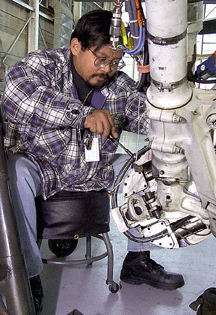|
|
|
EDWARDS AIR FORCE BASE, Calif. (AFPN) -- An F-16 Falcon modified with an electric brake system took to the skies here recently, marking the first time an airplane equipped with electric brakes, or e-brakes has been flown.
The 416th Flight Test Squadron here, along with team members from B.F. Goodrich, Lockheed Martin and Boeing, is currently testing the e-brake system.
The B.F. Goodrich-designed e-brake system performs well and has a similar feel to hydraulic brake systems currently used in airplanes, said Project Manager Alan Dykhoff, 416th FTS.
Typical airplane brakes consist of three or four rotors that spin with the plane's wheel next to stationary carbon pads. Several hydraulic pistons surround the rotor/pad stack, and when a pilot steps on the brakes, the pistons squeeze the whole stack together. Friction between the rotors and carbon pads slows the aircraft down.
The e-brake system replaces the hydraulic piston actuator with electric motors and gearing to squeeze the brake stack.
Results from the flight test project will provide more information on the feasibility of building future aircraft with e-brakes, Dykhoff said.
"There is a general tendency toward all-electric airplanes," he said. "The e-brake project is just one element."
Why the move towards electric components? Electric systems are easier to maintain, Dykhoff explained. Aircraft maintainers can run diagnostics of electric systems with computers, rather than physically disassembling and inspecting hydraulic components.
Also, aircraft computers constantly monitor an electric system's status, so if something goes wrong with the system, a pilot will know immediately. A pilot is less aware of a hydraulic system's status.
To prepare for testing the e-brake system, aircraft modification technicians with the 412th Equipment Maintenance Squadron here installed the system on an F-16. The modification included replacing existing brake-control and anti-skid computers with a digital brake-control computer designed to work with the e-brakes.
The 416th test team started testing the e-brake system with low-speed taxi tests. One aspect of the taxi tests included ensuring the test pilot could use the e-brakes to help steer the airplane.
"Pilots often steer airplanes with differential braking," Dykhoff explained. "They will brake with one side and not the other, which pulls the aircraft towards the side where the brake is being applied."
The test team gradually increased the speed of the taxi tests, eventually reaching takeoff/landing speed.
They also tested the airplane's braking performance when the plane was at its lightest weight in fuel, which is when the brakes are more likely to lock.
The brakes' performance was also tested on a wet runway. The fire department coated a portion of the runway in foam and water, significantly reducing friction.
"This was a good test for the anti-skid system," Dykhoff said.
"By the time we got to the flight, things were easier," he said, because, "we pushed the system hard during initial ground tests."
The squadron tested some aspects of the system during flight that couldn't be tested on the ground. One such test determined whether the e-brake system stopped the wheels from spinning after the wheels were retracted. Wheels could damage a plane if retracted while still spinning, so brake systems are designed to automatically stop retracting wheels from spinning.
Upcoming tests will include comparing the performance of hydraulic pistons versus electric motors while the rest of the brake control system remains configured for electric brakes.
The e-brake test project originated from a cooperative research and development agreement between the Air Force Research Lab at Wright-Patterson Air Force Base, Ohio, and B.F. Goodrich.
